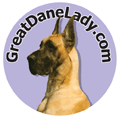 |
GREATDANELADY.COM Linda Arndt ~ Canine Nutritional Consultant Email: |
 |
|
Great Dane Review Article On HOD |
|
Introduction: Below is a research article on HOD - in addition to this information here are helpful link to determine if your pet has HOD and how to handle it. Blackwatch
Feed Program for HOD - Help(all large/giant breed puppies)
Risk of Hypertrophic Osteodystrophy in Great Danes Increases With Overfeeding and Supplementation This
article is reprinted intact from the Purina Pro Club Great Dane Review
Vol. 1 No.2 July 2002
Hypertrophic Osteodystrophy Is Sometimes Called:
Hypertrophic 0steodystrophy (HOD), a skeletal disorder of rapidly growing large and giant breed puppies, is more likely to affect Great Dane puppies than any other breed, according to the results from a survey conducted in 1998 [Munjar TA; Austin CC; Bruer GJ]. "HOD occurs unexpectedly in puppies 4 to 6 months old," says Herman Hazewinkel, D.v.M., Ph.D., professor of veterinary medicine at Utrecht University in the Netherlands. "The disease is painful and crippling, affecting both front or both back limbs, or all four." The condition may begin with uncharacteristic listlessness, fever, or even partial paralysis, usually in the rear. A puppy may be lame, refuse to stand, lose appetite and weight, and its temperature may skyrocket to 104 degrees Fahrenheit. When a veterinarian examines the x-ray of a puppy suffering form HOD, he or she sees clinical manifestations exclusive to disease Hazewinkle says. "A small, irregular black line appears just above and parallel to the growth plate, but separated from it by a dense band at a distance of 2 to 3 millimeters. The black line represents a fracture or a break in the bone. The dog is more or less suffering from a broken leg, but not just one leg - all legs. The fever probably is from the pain." Dogs with HOD have severe swelling near the growth plates, which are warm to the touch. Growth plates, which are located between the tabular part and bony ends of long bones, are responsible for the growth of bones and are softer than other areas of bone. It is the bony ends that swell, not the joints as is often thought. Since the longitudinal growth of bones continues for eight Auburn to 12 months, an injury during time can be devastating. The growth plate is the weak link in the architecture of the bone. Young bone is fragile as it undergoes continuous modeling, being built and resorbed or removed by bone-eating cells called osteoclasts. Researchers speculate that in HOD the osteoclasts are overactive removing too much bone. Several theories have been studied to explain the process. Seeking Causes of HOD Hazewinkel, a diplomat of the European College of Veterinary Surgeons and the European College for Veterinary and Comparative Nutrition, has conducted nutritional studies on Great Danes for many years. His research and other dietary studies on rapidly growing puppies suggest high levels of calcium and phosphorus in the diet and free access to food as contributing factors. A nutritional study on Great Danes in 1974 at Cornell University compared development of dogs that were given free access to food against a control group that was fed normally. Signs of HOD were found in the group with free access to food. Other studies, including one in 1986 at Utrecht University, seem to connect diets high in calcium and phosphorus with development of HOD in young growing Great Danes. In 1999, a group of scientists at auburn University also reported a connection between HOD and high calcium and phosphorus intake in Great Danes, even in conjunction with cranio mandibular osteopathy (CMO), a thickening of the jaw bone, in selected cases. "it is very hard to say if there is a link between food and HOD, although it can’t all be coincidental, " says Hazewinkel. HOD Treatment HOD strikes hard and fast, but usually in three weeks, puppies can walk again spontaneously. However, owners should not let them walk, "Hazewinkle says. In dogs with severe or chronic HOD, a calcified cuff of new bone may form around the periosteum, the soft tissue layer that covers the bone, adding length and diameter, further hobbling victims. In mild cases, the bone may remodel to a nearly normal shape. Still, owners should keep dogs quiet and still for the duration, or at least six weeks from the onset, to prevent further damage to the bone. Relapses may occur until the dog is grown. "There is little an owner can do besides nurse and nurture a puppy with HOD:' Hazewinkel says. "It takes time for a puppy to heal. It is important to provide a clean, soft bed, medicine such as aspirin to suppress fever and, if possible, intravenous fluids to help with hydration. Antibiotics may be indicated. It also is important to provide physical and moral support in the form of tender loving care." Dogs that are suffering from canine distemper virus have little recourse but to wait until their body builds up resistance to the virus. Dogs responding quickly to treatment for high fever have a good prognosis; however, they should be kept on fluids. In most cases, the fever eventually goes away. There are no early warning signals for HOD. Prevention leans heavily on moderation. "Puppies should not be overfed or supplemented," Hazewinkel says. "Study after study has shown that when you overfeed, you shorten the lifespan. Particularly, do not supplement with calcium and phosphorous or vitamin D."
|
|
|